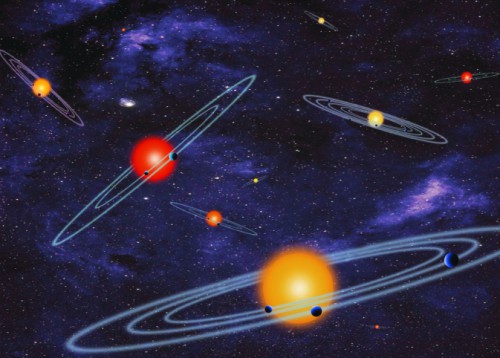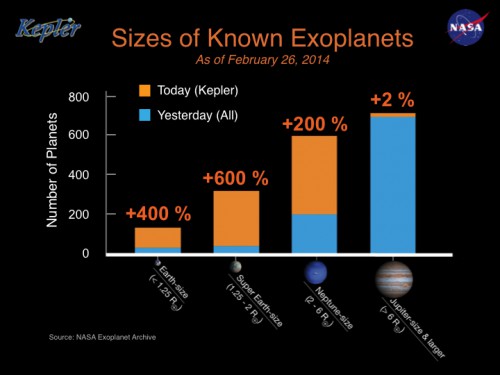
There was more exciting exoplanet news this week from the Kepler mission: the space telescope has confirmed 715 new exoplanets! This brings the current total number of such worlds to 1,766, of which 961 have been found by Kepler. There are still also 3,601 other Kepler planetary candidates awaiting confirmation.
The newly added planets orbit 350 stars, supporting previous findings that many stars have multiple planets, just like our own Sun.
As John Grunsfeld, associate administrator for NASA’s Science Mission Directorate in Washington stated, “The Kepler team continues to amaze and excite us with their planet hunting results. That these new planets and solar systems look somewhat like our own, portends a great future when we have the James Webb Space Telescope in space to characterize the new worlds.”
The announcement of the 715 new planets is by far the largest number of confirmed exoplanets to be announced at one time. Even during the teleconference this morning, scientists had to remind themselves that these are confirmed planets, not just candidates. Until now, it was primarily planetary candidates which would be announced in such large numbers.

According to Jack Lissauer, leader of the research team, “Four years ago, Kepler began a string of announcements of first hundreds, then thousands, of planet candidates – but they were only candidate worlds. We’ve now developed a process to verify multiple planet candidates in bulk to deliver planets wholesale, and have used it to unveil a veritable bonanza of new worlds.”
One of the most interesting aspects of the new findings is that nearly 95% of the these 715 worlds are smaller than Neptune, ranging down to about the size of the Earth. This again supports previous discoveries that such smaller worlds greatly outnumber larger gas giants like Jupiter. The number of known Earth-sized planets has now increased by 400%, compared to only 2% for Jupiter-sized or larger worlds. Super-Earth-sized planets (larger than Earth but smaller than Neptune) have increased by 600%.
Four of the planets orbit in the habitable zone of their stars, where liquid water could exist on a rocky planet’s surface, and all are 2.5 times the diameter of Earth or less.
The discoveries were made using a new planet-hunting technique called verification by multiplicity, which uses the logic of probability. Of the 150,000 stars that Kepler has in its unchanging field of view, a few thousand have planetary candidates. If they were to be distributed randomly among all of Kepler’s stars, only a handful would appear to have multiple planetary candidates. But in actuality, Kepler has found hundreds of those stars to have multiple planetary candidates. Of these, the newly-announced 715 planets have been confirmed so far.
The findings will be published on March 10 in The Astrophysical Journal. Much more information about the new planets is available here.
Want to keep up-to-date with all things space? Be sure to “Like” AmericaSpace on Facebook and follow us on Twitter: @AmericaSpace




Kepler is ONLY observing 150,000 Stars and they’ve already confirmed 715 planets (3,601 possible), just imagine if we could observe all Stars…? To think we’re the only intelligent life in the Universe is beyond arrogant!!! I wish I could see how far space travel goes in 200 years…2200-2300
I bet we figure out how to protect us from Space Radiation, duplicate gravity on board space crafts, and travel beyond light speed by then. So exiting!
It *is* exciting! I would just note too that the total number of confirmed planets from Kepler is now 961, including the 715 new ones. And there are so many more waiting to be confirmed and discovered. 🙂